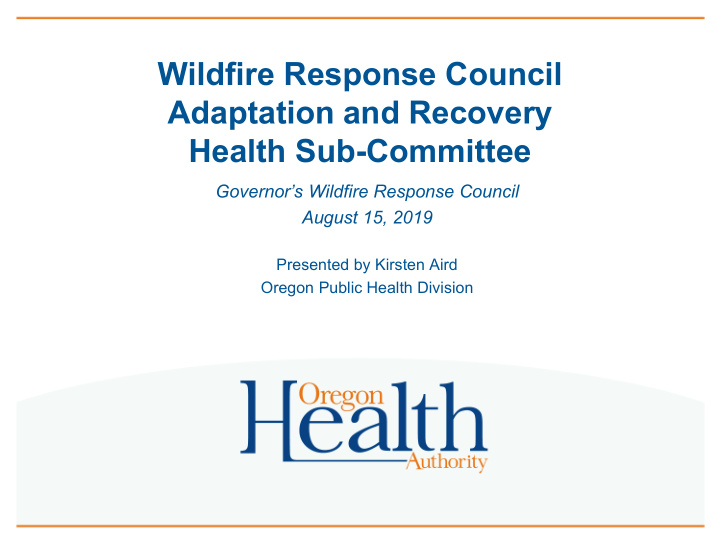



Wildfire Response Council Adaptation and Recovery Health Sub-Committee Governor’s Wildfire Response Council August 15, 2019 Presented by Kirsten Aird Oregon Public Health Division
Health Sub-Committee Members • Dr. David Bangsberg , Dean, School of Public Health, Oregon Health Sciences University- Portland State University • Katrina Holland , CEO, Community Alliance of Tenants (Wildfire Council Member) • Representative Pam Marsh , State Representative, (Wildfire Council Member) • Mike Harryman , State Resilience Officer • Eric Hunter , Care Oregon, (Wildfire Council Member) • Larry Deaton , St. Charles Hospital, Oregon Hospitals and Health Systems representative • Mark Long , Building Codes Oregon Health Authority-Public Health Division Staff • Wendy Polulech , Office of the State Public Health Director • Akiko Saito , Preparedness and Emergency Response, Manager • David Emme , Drinking Water Programs, Manager • Richard Leman, MD , Acute and Communicable Disease • Gabriela Goldfarb , Environmental Health, Manager
Recommendations 1. Clean Air Spaces 2. Integrated Prescribed Burning Plan 3. Environmental Public Health Infrastructure & Early Warning Systems 4. Oregon Emergency Management System 5. Tenants’ Rights
Recommendation 1: Clean Air Spaces Increase access to cleaner air spaces during a smoke event regardless of the source of smoke, prescribed burn or wildfire smoke. – Air Filtration Systems – Public Clean Air Spaces • What is the best and most cost effective way to increase access to clean air spaces? – Individuals vs. the public? – Is the committee open to making recommendations outside the normal scope of forests and land use? – Where should accountability sit?
Recommendation 2: Integrated Prescribed Burning Plan Build community resiliency to wildland fire and smoke for longer periods in the year, including the prescribed burn season (fall and spring). – Pace & Scale – Air Quality Monitoring – Health Impacts – Community outreach • Is this a phased in approach? What is phase one? – How do we address the health concerns from both the Oregon Health Authority and Environmental Quality Commission, regarding exposure to smoke? – Can we satisfy concerns with enough community infrastructure to protect people?
Recommendation 3: Environmental Public Health Infrastructure & Early Warning Systems Invest in Oregon’s environmental public health infrastructure and early warning systems to help communities prepare for projected health risks from wildfire and smoke. – Early warning systems – Smoke warning infrastructure – Water infrastructure – Back-up power sources as a result of mitigation decisions • The foundation for this is in place, what has been difficult about implementing this to date? What would it take to get us over the finish line?
Recommendation 5: Tenants’ Rights Pursuant to the Wildfire Council’s social justice objective, ensure tenants are not disproportionately affected by wildfire. – Smoke damage – Missed rent – Displacement & Relocation • Given these are primarily requiring changes in ORS Chapter 90, can these be bundled? What are unintended consequences we may be blind to?
Recommendation 4: Oregon Emergency Management System Increase awareness and efficiency of Oregon’s Emergency Management system and state and local agency collaborations in existence. Empower communities to strengthen their coordination locally. – Interagency Coordination – Outreach and awareness • What can we expect from local communities? What would it look like to increase coordination in Smoke Sensitive Receptor Areas, that may cross county and city jurisdictions?
Recommend
More recommend